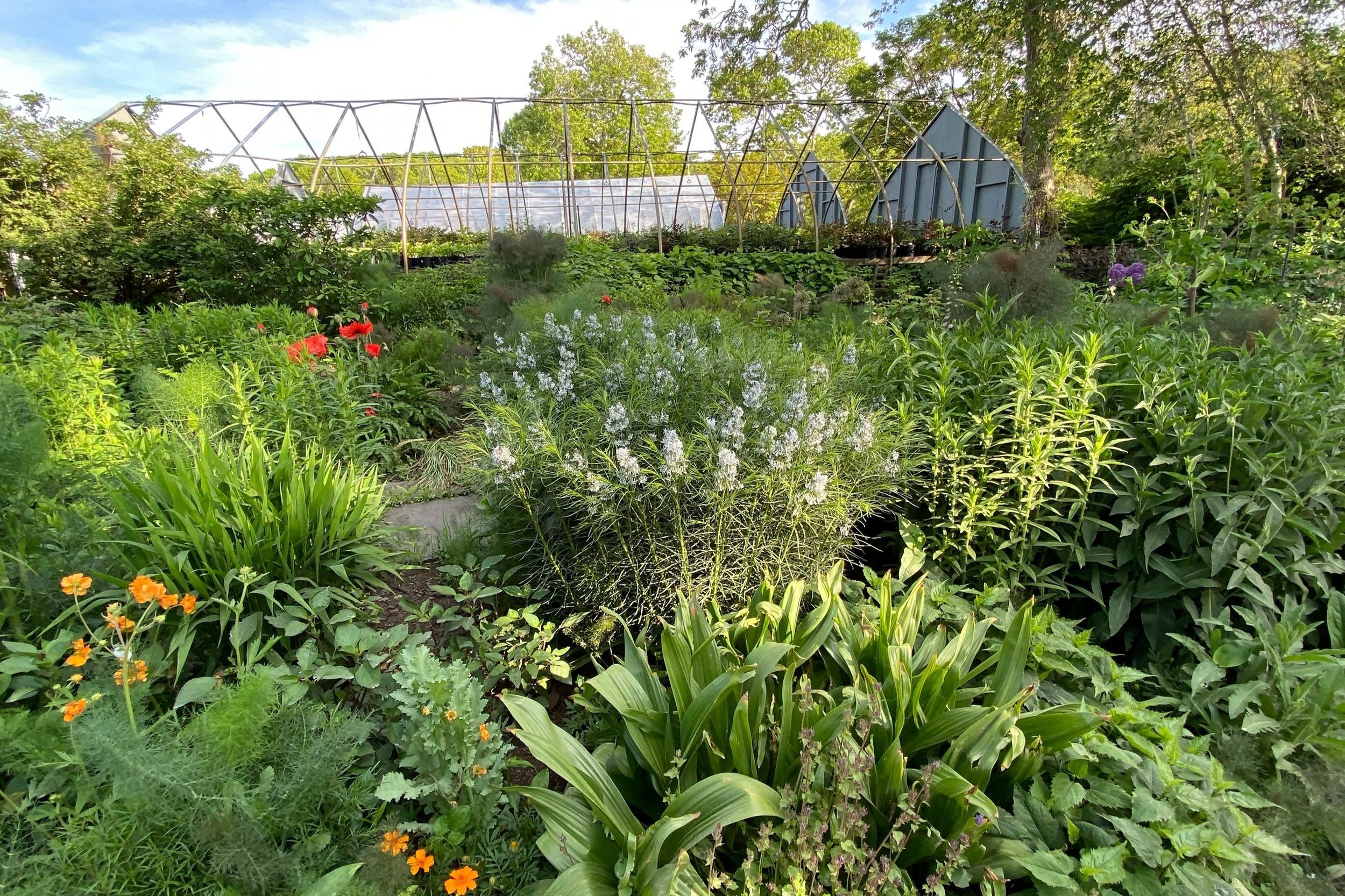********************
DEER IN YOUR GARDEN
Deer show distinct preferences to certain types of flowers. Plants that are soft to the touch with high water content (like hostas) are favorites, as well as buds and rhododendrons. Deer don’t seem to like plants with coarse, bristly, fuzzy, or spiny textures, nor do they enjoy those with intense aromas. That said, if hungry enough, deer will eat anything. They will leave jagged damage on your plant leaves so you will know they have been to your house for dinner. The heaviest browsing by deer will occur from October through February, especially during difficult winter months.
Note: Even “resistant” varieties can be vulnerable in the first few weeks after planting. If you have major deer problems, we recommend spraying new plants with a deer-repellent for 3 to 4 weeks after planting to prevent them from being nibbled on and damaged. The plants should survive even if they are feasted on, as long as the root systems of the plants are not damaged.
Black Chokeberry, a deer resistant native shrub
Forget Me Nots & Bleeding Hearts are both deer resistant plants.
********************
CONTROL AND PREVENTION
How to Get Rid of Deer
There are many techniques you can try to deter deer from munching on your plants. Try some of these methods for your garden:
Spray flowers and shrubs with a deer repellent that contains a mixture of dried bovine blood, sulfured eggs, and garlic. These repellents are available at most home and garden stores. They will not harm your plants and are usually effective in deterring deer.
Scatter or hang bars of deodorant or cheap motel soap around the garden; if you leave the wrappers on, the soap will last longer. Irish Spring is particularly recommended.
For your garden, choose flowers and shrubs that are unpalatable to deer, such as forsythia, lilac bush, marigolds, zinnias, daffodils, lavender and snapdragons. Contact your local cooperative extension for suggestions in your area. Here is the Almanac’s list of deer-resistant plants.
Put strong-smelling plants that deer don’t like on the outside of your garden and smaller plants that need more protection on the inside. Deer tend to stay away from poisonous plants, strongly flavored plants, and plants with hairy or furry leaves.
The most reliable method is to fence in your garden. We sell a black vinyl fence for keeping deer out. The fence needs to be at least 8ft tall. A strong 8ft metal fence would work nicely but that can get quite expensive.
Plastic deer fencing
Plastic deer fencing
Wooded gate & plastic deer fencing
Wooden gate & plastic deer fencing
********************
DEER RESISTANT ANNUALS
Lantana ‘Sunrise Rose’
Alyssum
Calendula Bon Bon mix. A dwarf Calendula. Blooms all summer in full sun or part shade.
DEER RESISTANT ANNUALS
Acroclinum (Paper Flower)
Ageratum
Angelonia: Dwarf Serena, tall Angelonias and our favorite tall one is the Angel Face Series
Bachelor Buttons (Corn Flowers)
Bracteantha (Strawflower)
Brugmansia
Calendula (Angel's Trumpets)
Cleome (Spider Flowers)
Cosmos sulphureus: Cosmos Xanthos,Cosmos Apricotta and our new Cosmos Diablo
Datura (Trumpet Flower)
Delphinium (Larkspur)
Dusty Miller (Silver Ragwort)
Euphorbia marginatá ‘Snow on the Mountain’
Geraniums (Crane's Bill)
Geraniums (scented)
Gomphrena (Globe amaranth)
Gypsophila (Baby's Breath)
Heliotropium (Heliotrope)
Herbs (annuals): cilantro / parsley / dill / chervil / lemon grass / lavender / lemon verbena / marjoram
Lantana
Limonium (Statice) (Sea lavenders)
Lobularia maritima (Alyssum)
Papaver (Poppies)
Salvias
Tagetes (Marigolds)
Heliotrope Fragrant Delight
Lantana
Salvia “Amistad” (annual and season extender)
********************
DEER RESISTANT PERENNIALS
Nepeta “Walkers Low’ catmint
Pennisetum Moudry-black fountain grass blooms in late summer
Bearded Iris
DEER RESISTANT PERENNIALS
Achillea (Yarrow)
Aconitum (Wolf's bane)
Agastache (Anise hyssop)
Allium Ornamental Onion)
Alpestris (Forget-Me-Nots)
Amsonia (Blue Stars)
Ariseama (Jack-in-the-Pulpit)
Arum (Arum Lilies)
Aruncus (Goatsbeard)
Artemesia (Mugworts)
Asarum (Wild Gingers)
Asclepias tuberosa (Butterfly Weed)
Aster
Astilbe (False Goatsbeard)
Baptisia (Wild Indigo)
Borage
Bronze Fennel
Cimicifuga (Bugbane)
Coreopsis verticillata ‘Zagreb’ and ‘Moonbeam’ (Whorled Tickseed)
Corydalis
Dicentra (Bleeding Heart)
Digitalis (Foxglove)
Dryopteris (Wood Ferns)
Echinops (Globe Thistle)
Epimedium (Barrenwort)
Euphorbia (Spurges)
Festuca glauca (Blue Fescue)
Helleborus (Hellebore)
Herbs (perennial): Rosemary / thyme / sage / tarragon / mints / Rue
Iris: Bearded, Japanese and Siberian Iris
Kirengeshoma (Yellow Wax Bells)
Lavandula (Lavender)
Liatris (Blazing stars)
Lily if the valley
Marrubium vulgare (Horehound)
Melissa officinalis (Lemon balm)
Mint family perennials
Monarda (Beebalm)
Narcissus (Daffodils)
Nepeta (Catnips)
Oregano Drops of Gold Jupiter (new)
Oregano: ornamental and edible
Ornamental Grasses
Osmunda Fern (Royal Fern)
Pachysandra
Paeonia (Peonies)
Papaver (Poppies)
Perovskia (Russian Sage)
Salvia
Stachys bizantina (Lambs Ears)
Teucrium (Germanders)
Yucca
Echinops, Globe Thistle
Dicentra Bleeding Hearts
Hellebores
Thyme Lemon Variegated
Helictotrichon Saphirsprudel
Foxglove
Amsonia hubrichtii
********************
DEER RESISTANT TREES & SHRUBS
Lilac
Pieris japonica
DEER RESISTANT TREES & SHRUBS
Abelia
Acer (Maple)
Aesculus (Horse Chestnut)
Amelanchier (Serviceberry)
Aralia (Spikenards)
Arctostaphylos uva-ursi (Bearberry)
Aronia (Chokeberry)
Aucuba (spotted laurel)
Betula (Birch)
Buddleja davidii (Butterfly Bush)
Buxus (Boxwood)
Callicarpa (Beautyberry)
Calycanthus floridus (Sweet Shrub)
Calycanthus virginicum (Carolina Allspice)
Caryopteris (Bluebeard)
Cercidiphyllum (Katsura)
Chaenomeles (Flowering Quince)
Chamaecyparis (False Cypress)
Chionanthus
Clerodendron trichotoma (Harlequin Glorybower)
Clethra (Sweet Pepperbush)
Cotinus (Smoke bush)
Cornus (Dogwood)
Cotoneaster (Bearberry cotoneaster)
Cryptomeria (sugi)
Daphne
Deutzia
Enkianthus
Forsythia
Fothergilla
Gleditsia
Hamamelis (Witch-hazel)
Hibiscus syriacus (Rose of Sharon)
Hypericum (St. Johns Wort)
Ilex opaca (American Holly)
Ilex verticillata (Winterberry Holly)
Illicium floridanum (Florida Anise)
Itea virginica (Virginia sweetspire)
Juniperus (Junipers)
Kerria japonica
Kolkwitzia (Beauty Bush)
Symphoricarpos (Crepe Myrtle)
Leucothoe fontanesiana (Fetterbush)
Lindera (Spicebush)
Liriodendron tulipifera (tuliptree)
Magnolia
Mahonia aquifolium (Oregon Grape Holly)
Mahonia nervosa
Mahonia repens
Metasequoia (dawn redwood)
Microbiota decussata (Siberian Cypress)
Myrica pensylvanica (Bayberry)
Nellia sinensis
Osmanthus (Devilwood)
Oxydendrum (sorrel tree)
Philadelphus (Mock oranges)
Picea glauca (Alberta Spruce)
Pieris japonica (Andromeda)
Pines
Potentilla (Cinquefoil)
Prunus laurocerasus (Cherry Laurel)
Prunus maritima (Beach plum)
Prunus serrulata (Japanese Cherry)
Rhus (Sumac)
Rubus (Trailing Blackberry)
Salix (Willows)
Sambucus (Elderberry)
Sarcococca hookeriana (Sweetbox)
Skimmia
Spirea (Meadowsweets)
Symphoricarpos (Coralberry)
Syringa vulgaris (Lilac)
Viburnum dentatum (Arrowwood Viburnum)
Weigela
Wisteria
Clethra
Fothergilla
Spirea
Callicarpa
variegated Boxwood
Monrovia deer resistant plants









